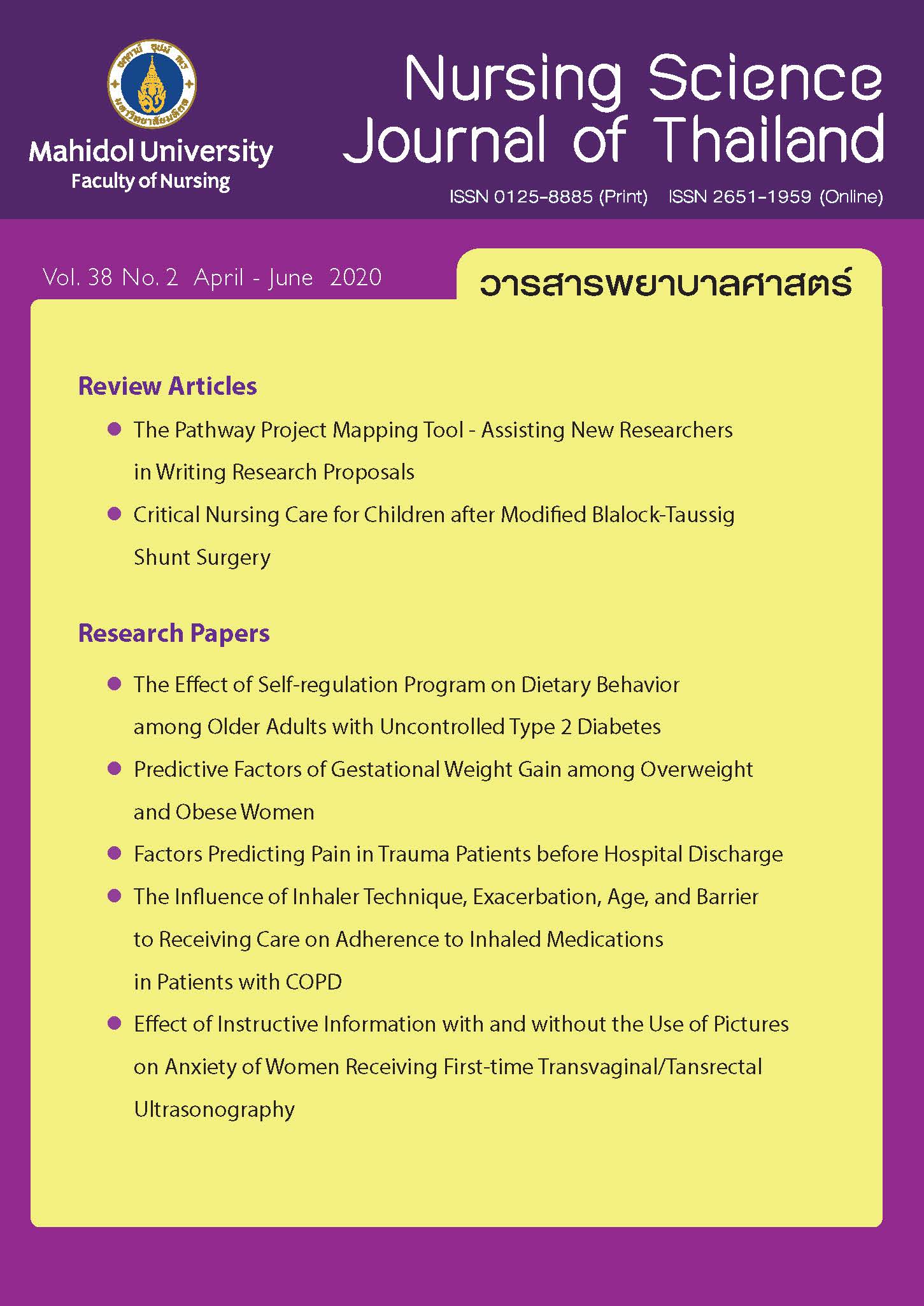Critical Nursing Care for Children After Modified Blalock-Taussig Shunt Surgery
Main Article Content
Abstract
Modified Blalock-Taussig Shunt placement (MBTS) is one of the palliative surgeries to enhance pulmonary blood flow in patients with cyanotic congenital heart disease. To prevent and timely treat the specific complications of this operation, skill and knowledge of nurses and caregivers are essential. These complications include acute shunt thrombosis, inadequate pulmonary blood flow, and pulmonary overflow. Nurses can assist and collaborate with attending physicians for the care of the patients, for improvement of survival and quality of life for the patients and their families.
Article Details
Copyright Notice: Nursing Science Journal of Thailand has exclusive rights to publish and distribute the manuscript and all contents therein. Without the journal’s permission, the dissemination of the manuscript in another journal or online, and the reproduction of the manuscript for non-educational purpose are prohibited.

Disclaimer: The opinion expressed and figures provided in this journal, NSJT, are the sole responsibility of the authors. The editorial board bears no responsibility in this regard.
References
Somchue N, Sanasuttipun W, Srichantaranit A. The effect of a teaching program on knowledge and behaviors of caregivers to promote nutrition in children with acyanotic congenital heart disease. Journal of Nursing Science. 2016;34(3):79-93. (in Thai).
Thamjamratsri K, Prangvatanagul W. Critical congenital heart disease screening in seonates in Prapokklao Hospital. Journal Prapokklao Hospital Clinic Medication Education Center. 2019;36(2):134-41. (in Thai).
The Society of Thoracic Surgeons of Thailand. Statistical statistics for heart surgery in Thailand from 2001 - present [Internet]. Bangkok: The Society of Thoracic Surgeons of Thailand; 2005 [cited 2019 Dec 20] Available from: https://thaists.org/news_detail.php?news_id=212. (in Thai).
NHS Greater Glasgow and Clyde. Modified Blalock-Taussig Shunt (MBTS), immediatepost-operative management [Internet]; Glasgow Scotland: NHS Greater Glasgow and Clyde; 2020 [cited 2019 Dec 20] Available from: https://www.clinicalguidelines.scot.nhs.uk/ggc-paediatric-guidelines/ggc-guidelines/cardiovascular-diseases/Modified-blalock-taussig-Shunt-mbts-immediate-post-operative-management/
Kiran U, Aggarwal S, Choudhary A, Uma B, Kapoor PM. The Blalock and Taussig shunt revisited. Ann Card Anaesth. 2017;20(3):323-30. doi: 10.4103/aca.ACA_80_17.
Petrucci O, O’Brien SM, Jacobs ML, Jacobs JP, Manning PB, Eghtesady P. Risk factors for mortality and morbidity after the neonatal Blalock-Taussig shunt procedure. Ann Thorac Surg. 2011;92(2):642–51. doi: 10.1016/j.athoracsur.2011.02.030.
McKenzie ED, Khan MS, Samayoa AX, Vener DS, Ishak YM, Santos AB, et al. The Blalock-Taussig shunt revisited: a contemporary experience. J Am Coll Surg. 2013;216(4):699-704. doi: 10.1016/j.jamcollsurg.2012.12.027.
Shahidi M, Bakhshandeh H, Rahmani K, Afkhamzadeh A. Hypomagnesaemia and other electrolytes imbalances in open and closed pediatrics cardiac surgery. Pak J Med Sci. 2019;35(2):353–9. doi: 10.12669/pjms.35.2.367.
Polderman KH, Girbes AR. Severe electrolyte disorders following cardiac surgery: a prospective controlled observational study. Crit Care. 2004;8(6):R459–66. doi: 10.1186/cc2973.
Colson PH, Gaudard P, Fellahi JL, Bertet H, Faucanie M, Amour J, et al. Active bleeding after cardiac surgery: a prospective observational multicenter study. PLoS One. 2016;11(9):e0162396. doi: 10.1371/journal.pone.0162396.
Perez Vela JL, Martín Benitez JC, Carrasco Gonzalez M, de la Lopez MA, Hinojosa Perez R, Sagredo Meneses V, et al. Summary of the consensus document: “clinical practice guide for the management of low cardiac output syndrome in the postoperative period of heart surgery”. Med Intensiva. 2012;36(4):277-87. doi: 10.1016/j.medin.2012.01.016.
Li JS, Yow E, Berezny KY, Rhodes JF, Bokesch PM, Charpie JR, et al. Clinical outcomes of palliative surgery including a systemic-to-pulmonary artery Shunt in infants with cyanotic congenital heart disease: does aspirin make a difference? Circulation. 2007;116:293-97.
Lok JM, Spevak PJ, Nichols DG. Tricuspid atresia. In: Nichols DG, Lok JM, Spevak PJ, Nichols DG, editors. Critical heart disease in infants and children. Philadelphia: Mosby Inc; 2010. p.806-7.
Peter D. Post operative cardiovascular dysfunction pharmacologic support. In: Lake CL, Booker PD, editors. Pediatric cardiac anesthesia. 4th ed. Philadelphia: Lippincott Williams and Wilkins; 2005. p.654-81.
NHS Greater Glasgow and Clyde. Cardiac post-op patients: anti-coagulation therapy in PICU [Internet]. Glasgow, Scotland: NHS Greater Glasgow and Clyde; 2020 [cited 2019 Aug 17]. Available from: https://www.clinicalguidelines.scot.nhs.uk/ggc-paediatric-guidelines/ggc-guidelines/cardiovascular-diseases/cardiac-post-op-patients-anti-coagulation-therapy-in-picu/
Ismail SR, Almazmi MM, Khokhar R, AlMadani W, Hadadi A, Hijazi O, et al. Effects of protocol-based management on the post-operative outcome after systemic to pulmonary shunt. Egypt Heart J. 2018;70(4):271–8. doi: 10.1016/j.ehj.2018.09.007.
Kuck M, Ozdemir R, Karacelik M, Doksoz O, Karadeniz C, Yozgat Y, et al. Risk factors for thrombosis, overshunting and death in infants after modified blalock-taussig shunt. Acta Cardiol Sin. 2016;32(3):337-42.
Kim KH, Oh KY. Clinical applications of therapeutic phlebotomy. J Blood Med. 2016;7:139–44. doi: 10.2147/JBM.S108479.
Marchioli R, Finazzi G, Specchia G, Cacciola R, Cavazzina R, Cilloni D, et al. Cardiovascular events and intensity of treatment in polycythemia vera. N Engl J Med. 2013;368(1):22–33. doi: 10.1056/NEJMoa1208500.


